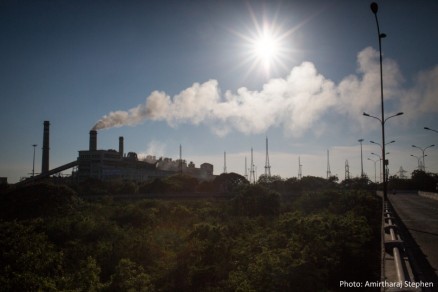
Alarmingly high levels of harmful air pollutants can be found in communities in the Ennore region, a suburb of Chennai surrounded by a cluster of coal-fired power plants, according to a new report by the Chennai-based Coastal Resource Centre (CRC), a partner of the Healthy Energy Initiative.
The report, entitled “Unfit to Breathe,” notes that the fine particle pollution found in the air samples collected from residential rooftops in Ennore is comprised of a high fraction of four elements (aluminum, calcium, iron, and silicon) that occur in high levels in coal ash, a waste product from coal combustion. This elemental composition suggests that the overall fine particle pollution found in the Ennore region is impacted by coal ash emissions, and not significantly impacted by sources of liquid fuel combustion (such as vehicle emissions and diesel generators) alone.
The CRC noted that Ennore is a hydrologically sensitive area that has become the ‘power capital’ of Chennai, hosting four coal-fired power plants with a combined capacity of 3,780 MW, with another three plants proposed totaling an additional 3,320 MW. The area is also home to two ports. The combined result on the ecosystem has significant health repercussions that the CRC report has begun to elucidate.
Health implications and health interventions
According to Dr. Rakhal Gaitonde, a public health specialist, “The air sampling results show a very concerning level of toxic substances that adversely effect health. Their presence at such high levels shows that there is a significant possibility of chronic health effects.”
Noting the neuro-toxic and carcinogenic effects of some of the pollutants, as well as the scientific validity of the sampling technique, Dr. Gaitonde concluded that “there is an urgent need not only to take immediate steps to reduce the presence of such toxins in the air, but also to institute a comprehensive health survey to assess what damage has already been done, and institute follow up of the population for detecting long term harm from the exposure till now. Further the health system needs to take these chemicals into account and develop a plan on how to provide relevant and adequate care to those who have been exposed.”
Fine particles (PM2.5)
The air samples taken from four villages within 2-3 km of the nearest coal plant or coal ash pond revealed PM2.5 levels ranging from 105.7 to 141.5 µg/m3, or 1.7 to 2.3 times higher than the standards prescribed by India’s Ministry of Environment, Forests and Climate Change (MoEFCC). Had these levels of PM2.5 been found in the US, the US Environmental Protection Agency (USEPA) would issue an advisory for unhealthy air quality. These levels were also 2.1 to 3.8 times higher than those recorded in Manali, deemed by the Central Pollution Control Board (CPCB) as a critically polluted area, according to air samples recorded on the same dates by the CPCB.
PM2.5, or fine particles measuring less than 2.5 micrometers in diameter, is both emitted directly as well as formed by precursor gases during coal combustion. PM2.5 is of particular health concern because fine particles can travel deep into the lungs, resulting in respiratory and cardiovascular effects including lung disease, decreased lung function, asthma attacks, lung cancer, heart attacks, and cardiac arrhythmia.
Heavy metals (Manganese, Lead, Arsenic, Nickel)
The report also revealed high levels of four heavy metals in the air samples, using comparisons with international health-based standards in the absence of Indian state and national standards for heavy metal
- Manganese levels in all four samples were above the California Office of Environmental Health Hazard Assessment (OEHHA) standard for long-term exposure by 1.2 to 2.5 times. Manganese exposure causes adverse neurodevelopmental and neurobehavioral health effects.
- Lead levels in two samples exceed the USEPA’s standard for long-term exposure by 1.07 to 3.7 times. Lead exposure causes adverse neurodevelopmental and neurobehavioral health effects, with children being particularly vulnerable to its effects on IQ, learning, memory, and behavior. There is no safe level of lead in the body.
- The arsenic level in one sample exceeds the Indian MoEFCC annual standard by 1.25 times. Arsenic exposure is associated with a range of health effects including cancers, gastrointestinal effects, nervous system disorders, and irritation of skin and mucous membranes.
- The nickel levels in one sample exceeds the California OEHHA’s standard for long-term exposure by 1.2 times. Nickel exposure causes adverse immune system and respiratory system impacts, and increases the risk of lung and nasal cancers.
Recommendations
Based on these findings and observations, the CRC recommends that the Tamil Nadu Pollution Control Board should improve monitoring and health advisory efforts, use pollution data to apprehend polluters and take corrective actions, commission a Cumulative Environmental and Health Impact Assessment in four densely industrialized areas, enforce a moratorium on the expansion of coal-fired power plants and other polluting industries pending the findings of the study, provide long-term health monitoring for residents and workers in the area, and provide health care services at the polluters’ cost for the pollution-impacted residents and workers.
For more information
- Download the report, “Unfit to Breathe”
- View the press release from the Coastal Resource Centre
- Read about the findings in the Times of India, The Hindu, The New Indian Express, and Deccan Chronicle.



